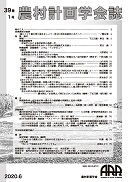
- Issue 4 Pages 350-
- Issue 3 Pages 274-
- Issue 2 Pages 104-
- Issue 1 Pages 7-
- Issue Special_Issue P・・・
- |<
- <
- 1
- >
- >|
-
Mitsuru NODA2020 Volume 39 Issue 1 Pages 7-10
Published: June 30, 2020
Released on J-STAGE: June 30, 2021
JOURNAL FREE ACCESSDownload PDF (911K)
-
Masashi TAMAHARA2020 Volume 39 Issue 1 Pages 11-14
Published: June 30, 2020
Released on J-STAGE: June 30, 2021
JOURNAL FREE ACCESSDownload PDF (479K) -
Masakazu YAMAUCHI2020 Volume 39 Issue 1 Pages 21-24
Published: June 30, 2020
Released on J-STAGE: June 30, 2021
JOURNAL FREE ACCESSDownload PDF (452K) -
Shigeki MAEDA2020 Volume 39 Issue 1 Pages 29-32
Published: June 30, 2020
Released on J-STAGE: June 30, 2021
JOURNAL FREE ACCESSDownload PDF (353K) -
Commons by Space Use and Its SignificanceAtsunori MIYAZAKI2020 Volume 39 Issue 1 Pages 33-36
Published: June 30, 2020
Released on J-STAGE: June 30, 2021
JOURNAL FREE ACCESSDownload PDF (645K) -
Takayuki HIRATA2020 Volume 39 Issue 1 Pages 39-42
Published: June 30, 2020
Released on J-STAGE: June 30, 2021
JOURNAL FREE ACCESSDownload PDF (428K) -
The Future of the Fishing Settlement through the Fishery Successor Center Project in Ishinomaki CityNobutake SATO, Momoyo KAIJIMA, Takuya HASEGAWA2020 Volume 39 Issue 1 Pages 43-46
Published: June 30, 2020
Released on J-STAGE: June 30, 2021
JOURNAL FREE ACCESSDownload PDF (585K)
-
Ine Town Activity ReportKenji SUGIMOTO2020 Volume 39 Issue 1 Pages 27-28
Published: June 30, 2020
Released on J-STAGE: June 30, 2021
JOURNAL FREE ACCESSDownload PDF (274K) -
The Case of Community Laboratory in Kada, Wakayama PrefectureYoshiko AOKI2020 Volume 39 Issue 1 Pages 37-38
Published: June 30, 2020
Released on J-STAGE: June 30, 2021
JOURNAL FREE ACCESSDownload PDF (309K) -
Mai YOSHIMURA2020 Volume 39 Issue 1 Pages 47-48
Published: June 30, 2020
Released on J-STAGE: June 30, 2021
JOURNAL FREE ACCESSDownload PDF (245K)
-
A Case Study of Seinaiji District, Achi-villageSugito HABA, Kenichiro ONITSUKA, Satoshi HOSHINO, Natsuki SHIMIZU2020 Volume 39 Issue 1 Pages 55-63
Published: June 30, 2020
Released on J-STAGE: June 30, 2021
JOURNAL FREE ACCESSThis paper seeks to ascertain the relationship between homophily (in a sense of perceived well-being) and settlement, using a case study of Achi village in Nagano prefecture, Japan based on a 2011 survey and follow-up interviews. Achi village consists of eight areas. One of these areas, Seinaiji, had an increased population projection while the other seven areas showed a decline. In 2011, the Achi Development Public Corporation conducted an intensive questionnaire survey of all households in the village to facilitate the development of local policy regarding village public services, industrial development and so forth. In 2017-2019, interviews were conducted to obtain qualitative data regarding immigrant and settler relations. Principal component analysis was applied to summarize sense of perceived well-being. Three components were extracted. They were 1) importance of a natural environment and a social base, 2) local activities, and 3) economic well-being. Households were divided into four groups by areas (Seinaiji area/ the other areas) and length of residence (short-term; up to 5 years / long-term; 5 years or more) and the average values of the component scores were then cross-compared. Comparing the average component scores among the four groups, three points can be derived. Firstly, newcomers in Seinaiji have similar well-being values to long-term residents, perhaps because of contact with long-term residents prior to migration. Secondly, newcomers in other areas have different well-being values to long-term residents, perhaps because of a lack of contact with long-term residents prior to migration. Thirdly, there is a probability communication between residents and newcomers changed the sense of well-being similarly within each of the two groups. This may be conditional upon factors to be ascertained through further research. It is proposed these results hold some implications for rural in-bound settlement policy for newcomers.
View full abstractDownload PDF (1968K)
- |<
- <
- 1
- >
- >|